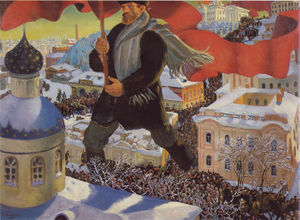Russian Social Democratic Labour Party
The Russian Social-Democratic Labour Party, or RSDLP (Russian Росси́йская Социа́л-Демократи́ческая Рабо́чая Па́ртия = РСДРП), also known as the Russian Social-Democratic Workers' Party and the Russian Social-Democratic Party, was a revolutionary socialist Russian political party formed in 1898 in Minsk to unite the various revolutionary organizations into one party. The RSDLP later split into Bolshevik and Menshevik factions, with the Bolsheviks eventually becoming the Communist Party of the Soviet Union. The Mezhraiontsy were also formed from this party.
Contents |
In Russia
The RSDLP was not the first Russian Marxist group; the Emancipation of Labour group was formed in 1883. The RSDLP was created to oppose narodnichestvo (наро́дничество), revolutionary populism, which was later represented by the Socialist-Revolutionary Party (SRs; Esers, эсе́ры). The RSDLP program was based on the theories of Karl Marx and Friedrich Engels - that, despite Russia's agrarian nature, the true revolutionary potential lay with the industrial working class. The RSDLP was illegal for most of its existence; at the end of the first party congress in March 1898, all nine delegates were arrested by the Imperial Russian Police.
Before the Second Congress, a young intellectual named Vladimir Ilyich Ulyanov (Влади́мир Ильи́ч Улья́нов) joined the party, better known by his pseudonym - Lenin (Ле́нин). In 1902 he had published What is to be Done?, outlining his view of the party's task and methodology - to form 'the vanguard of the proletariat.' He advocated a disciplined, centralised party of committed activists.
In 1903, the Second Congress of the party met in exile in Brussels to attempt to create a united force. However, after unprecedented attention from the Belgian authorities the congress moved to London, meeting on August 11 in a clubroom in Charlotte Street.[1] At the congress, the party split into two irreconcilable factions on November 17: the Bolsheviks (большеви́к; from Bolshinstvo - Russian for "majority"), headed by Lenin, and the Mensheviks (меньшеви́к; from Menshinstvo - Russian for "minority"), headed by Julius Martov. Confusingly, the Mensheviks were actually the larger faction, however the names Menshevik and Bolshevik were taken from a vote held at the 1903 party congress for the editorial board of the party newspaper, Iskra ("Spark"), with the Bolsheviks being the majority and the Mensheviks being the minority. These were the names used by the factions for the rest of the party congress and these are the names retained after the split at the 1903 congress. Lenin's faction later ended up in the minority and remained smaller than the Mensheviks until the Russian Revolution of 1917.
It was Lenin's position on democratic centralism and on restricting party membership that caused the split. Lenin argued that creating a successful revolution required that party membership be limited only to professional full-time revolutionaries; whereas the Mensheviks favored a more open membership policy. Despite a number of attempts at reunification, the split proved permanent. As time passed, more ideological differences emerged. According to many historians , the Bolsheviks pushed for an almost immediate "proletarian" revolution, while the Mensheviks believed that Russia was still at too early a stage in history for an immediate working-class revolution, and believed a "bourgeois" revolution must precede the subsequent "proletarian" revolution.
The Third Congress of the party (1905) was held separately by the Bolsheviks. The Fourth Congress (1906) saw a formal reunification of the two factions, (with the Mensheviks in the majority), but the discrepancies between Bolshevik and Menshevik views became particularly clear during the proceedings.
The Fifth Congress of the party was held in London, England, in 1907; it consolidated the supremacy of the Bolshevik faction and debated strategy for communist revolution in Russia. Stalin never later referred to his stay in London [1].
The Social Democrats (SDs) boycotted elections to the First Duma (April-July 1906), but were represented in the Second Duma (February-June 1907). With the SRs, they held 83 seats. The Second Duma was dissolved on the pretext of the discovery of an SD conspiracy to subvert the army. Under new electoral laws, the SD presence in the Third Duma (1907–12) was reduced to 19. From the Fourth Duma (1912–17), the SDs were finally and fully split. The Mensheviks had five members in the Duma and the Bolsheviks had seven, including Roman Malinovsky, who was later uncovered as an Okhrana agent. From 1912 onwards, the Bolshevik faction was officially a separate party, known as the Russian Social Democratic Labour Party (bolshevik). The Bolsheviks seized power during the October Revolution in 1917 and, in 1918, changed their name to the Communist Party. They banned the Mensheviks after the Kronstadt Uprising of 1921.
In Estonia
In 1902 the Tallinn organization of the RSDLP was founded, which in 1904 was converted into the Tallinn Committee of the party. In November a parallel (that is, also directly under the CC of RSDLP) Narva Committee was created. Amongst other radicals, the Estonian RSDLP cadres were active in the 1905 revolution.
At the conference of the Estonian RSDLP organisations in Terijoki, Finland in March 1907 the Bolshevik supporters came into serious conflict with the Mensheviks.
In Latvia
At the Fourth (Unity) Congress of the RSDLP in 1906, the Latvian Social Democratic Workers Party entered the RSDLP as a territorial organisation. After the congress its name was changed 'Social-Democracy of the Latvian Territory'.[2]
References
See also
- Factions of the RSDLP
- Socialist-Revolutionary Party
|
||||||||||||||
|
||||||||||||||||||||||||||||||||||||||||||||
|
||||||||||||||
